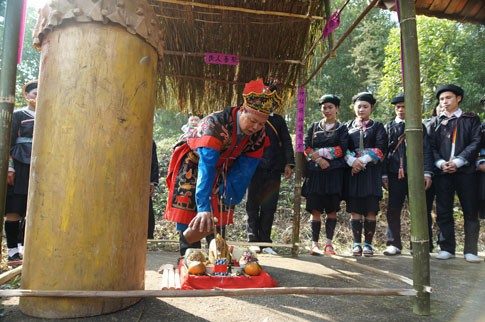The Giay still uphold the main elements of their customs and culture, including their traditional drum dancing festival.
Giay elders say that when their ancestors settled in Tat Nga, they built two temples called Mieu Ong and Mieu Ba, where local people could pray for peace and good luck.
They keep a big drum there that is used for community festivals. The drum is taken out only on the first day of each new year and returned to the temple the next day.
A Giay man named Vi Dau Min said, “The two temples were built hundreds of years ago to worship two deities. Mieu Ba is dedicated to a female deity in charge of land, crops, and good weather. Mieu Ong is dedicated to a male deity who is in charge of health, wealth, and happiness.”
The drum dancing festival is held on the first day of each new year. The Giay believe that the sound of the drum chases away the bad luck of the old year and welcomes good luck and peace into the new year.
People wear their best clothes to the New Year festival. They form a big circle to dance around the drum. The dance movements are simple and often imitate the motions of farm work. Men beat on the drumhead and women beat on the drum shell.
Vi Dau Min noted, “The first dance is to say farewell to the old year and the second dance is to pray for a bumper crop. The third dance is to ask the deities’ permission to take the drums out for a procession.”
The drum is 1 meter tall and has a diameter of about 60cm. The drumhead is made of leather. The drum shell is made of ironwood or jackfruit wood. To open the festival, a shaman performs a ritual to ask for the deities’ permission to take the drum out of the temples.
He also prays for the deities to protect the villagers and allow them to begin the festival. The Giay believe that the sound of the drum calls the attention of the Heaven God to their prayers.
After several rituals performed by the shaman, the drum is carried around the village. As the drum passes through each house, it is beaten to sound a prayer for peace and good luck for the owner of the house and his family.
Each household gives the members of the drum procession food. The next morning, the villagers come together to return the drum to its place in the temple until the following year’s festival.




